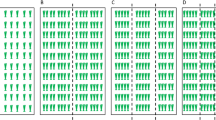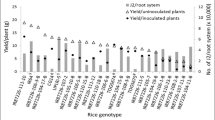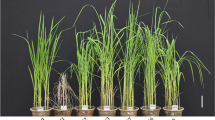Abstract
Two hundred seventy-three lines of the cultivated African rice species Oryza glaberrima Steud were screened in a paddy screenhouse at the National Cereals Research Institute, near Bida, Niger State, Nigeria for resistance to the African rice gall midge, Orseolia oryzivora Harris and Gagné, an increasingly important pest of lowland rice in Nigeria. Twenty entries which showed no galls in the screenhouse evaluation were retested under natural infestation in a gall midge-endemic field location near Abakaliki, Ebonyi State. Whereas the susceptible check variety, FARO 37, had 39.6 % of tillers infested 60 days after transplanting, damage in the test entries ranged from 0 to 3.7 %, an indication that they were all highly to moderately resistant to the pest. Greater host plant resistance is a central requirement for more effective management of O. oryzivora. Using resistance genes from O. glaberrima is a promising approach to achieving this.
Résumé
A l’Institut National de Recherche sur les Céréales de Bida (Niger State) au Nigéria, 263 lignées d’une espèce de riz africain cultivé Oryza glaberrima Steud, ont été évaluées en serre pour leur résistance à l’attaque par le moucheron à galle, Oryseolia oryzivora Harris and Gagné, u,n ravageur de plus en plus important dans les rizières de basses altitudes du Nigéria. Vingt entrées n’ayant pas montré de trace de galle en serre ont été ensuite testées sous des conditions d’infestations naturelles, dans un champs près d’Abakaliki (Ebonyi State), où la galle est reconnue endémique. Au moment où la variété (FARO 37) sensible de référence, avait 39,6% de talles infestées 60 jours après transplantation du riz, le taux d’attaque chez les entrées testées se rangeait entre 0 et 3,7%; ce qui était une indication sur la présence des entrées allant de hautement à moyennement résistantes au ravageur. Une très haute résistance de la plante constitue un préalable important pour une meilleure gestion de O. oryzivora. L’utilisation des gènes de résistance de O. glaberrima constituerait une approche prometteuse pour arriver à ce résultat.
Similar content being viewed by others
References
Brenère J. (1983) The Principal Insect Pests of Rice in West Africa and Their Control (2nd Edition). West Africa Development Association, Monrovia, Liberia. 87 pp.
Grist D. H. (1975) Rice (5th Edition). Longmans, London, UK. 601 pp.
Hardcastle J. E. Y. (1959) The development of rice production and research in the Federation of Nigeria. Trop. Agrie. (Trinidad) 36, 70–95.
Heinrichs E. A. and Pathak P. K. (1981) Resistance to the rice gall midge Orseolia oryzae in rice. Insect Sci. Applic. 1, 123–131.
IRRI (International Rice Research Institute) (1988) Standard Evaluation System for Rice (3rd Edition). IRRI, Los Baños, Philippines. 54 pp.
Jones M. P. (1995) Crossing African and Asian Rice Species. Advances in Rice Research. WARDA, Bouake, Côte d’Ivoire. 10 pp.
Joshi R. C, Ukwungwu M. N. and Winslow M. D. (1990) Rice ratoons as potential host for African rice gall midge. Int. Rice Res. Newsl. 15, 24.
Ng N. Q., Chang T. T., Vaughan D. A. and Zuno-Alto Veros C. (1991) African rice diversity: Conservation and prospects for crop improvement, pp. 213–227. In Crop Genetic Resources of Africa Vol. II (Edited by N. Q. Ng, P. Perrino, F. Attere and H. Zedan). IITA, Ibadan, Nigeria.
Ukwungwu M. N. (1986) Resistance of recommended and traditional varieties to gall midge. Int. Rice Res. Neivsl. 11, 8.
Ukwungwu M. N. (1990) Efficacy of granular isazofos against rice gall midge in Nigeria. Crop Prot. 9, 252–254.
Ukwungwu M. N. and Alam M. S. (1991) Field resistance of rice cultivars to the gall midge Orseolia oryzivora (Harris and Gagné) in Nigeria. Int. Rice Commission Neivsl. 40, 42–43.
Ukwungwu M. N. and Joshi R. C. (1992a) Evaluation of Asian gall midge resistant varieties for the African rice gall midge. Int. Rice Res. Neivsl. 17(5), 12.
Ukwungwu M. N. and Joshi R. C. (1992b) The distribution of the African rice gall midge, Orseolia oryzivora Harris and Gagné and its parasitoids in Nigeria. Trop. Pest Manage. 38, 241–244.
Ukwungwu M. N., Winslow M. D. and John V. T. (1989) Severe outbreak of gall midge, Orseolia oryzivora H. & G. in the savannah zone of Nigeria. Int. Rice Res. Neivsl. 14(4), 36–37.
Umeh E. D. N., Joshi R. C. and Ukwungwu M. N. (1992) Biology, status and management of rice insect pests in Nigeria. Crop. Prot. 11, 408–413.
Author information
Authors and Affiliations
Rights and permissions
About this article
Cite this article
Ukwungwu, M.N., Williams, C.T. & Okhidievbie, O. Screening of African Rice, Oryza glaberrima Steud, for Resistance to the African Rice Gall Midge Orseolia oryzivora Harris and Gagné. Int J Trop Insect Sci 18, 167–170 (1998). https://doi.org/10.1017/S1742758400007827
Accepted:
Published:
Issue Date:
DOI: https://doi.org/10.1017/S1742758400007827




